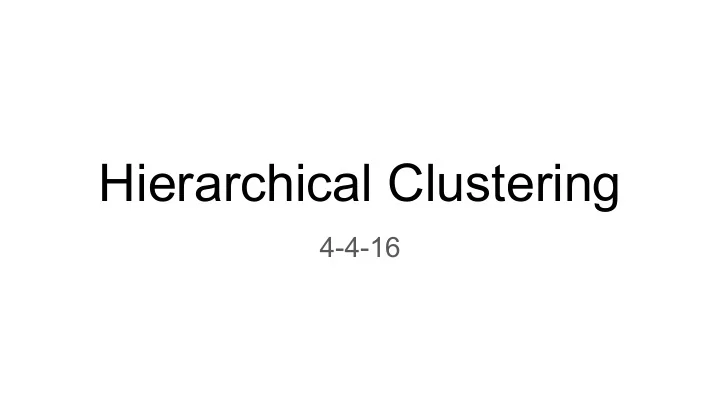

Hierarchical Clustering 4-4-16
Hierarchical clustering: the setting Unsupervised learning ● no labels/output, only x/input Clustering ● Group similar points together
Machine learning taxonomy Supervised Semi-Supervised Unsupervised Output known for training Occasional feedback No feedback set Highly flexible; can learn Learn the agent function Learn representations many agent components (policy learning) ● Clustering ● Regression ● value iteration ○ Hierarchical ○ K-means ● Classification ● Q-learning ○ GNG ○ Decision trees ● MCTS ● Dimensionality ○ Naive Bayes reduction ○ K-nearest neighbors ○ SVM ○ PCA
The goal of clustering Given a bunch of data, we want to come up with a representation that will simplify future reasoning. Key idea: group similar points into clusters. Examples: ● Identifying objects in sensor data ● Detecting communities in social networks ● Constructing phylogenetic trees of species ● Making recommendations from similar users
Hierarchical clustering ● Organizes data points into a hierarchy. ● Every level of the binary tree splits the points into two subsets. ● Points in a subset should be more similar than points in different subsets. ● The resulting clustering can be represented by a dendrogram.
Direction of clustering Agglomerative (bottom-up) ● Each point starts in its own cluster. ● Repeatedly merge the two most-similar clusters until only one remains. Divisive (top-down) ● All points start in a single cluster. ● Repeatedly split the data into the two most self-similar subsets. Either version can stop early if a specific number of clusters is desired.
Agglomerative clustering ● Each point starts in its own cluster. ● Repeatedly merge the two most-similar clusters until only one remains. How do we decide which clusters are most similar? ● Distance between closest points in each cluster (single link). ● Distance between farthest points in each cluster (complete link). ● Distance between centroids (average link). ○ The centroid is the average position of a cluster: the mean value of every coordinate.
Agglomerative clustering exercise Which clusters should be merged next? Under single link? Under complete link? Under average link?
Divisive clustering ● All points start in a single cluster. ● Repeatedly split the data into the two most self-similar subsets. How do we split the data into subsets? ● We need a subroutine for 2-clustering. ● Options include k-means and EM (Wednesday’s topics).
Similarity vs. Distance We can perform clustering using either a similarity function or a distance function to compare points. ● maximizing similarity ≈ minimizing distance Example similarity function: ● cosine of the angle between two vectors Distance metrics have extra constraints: ○ Triangle inequality. ○ Distance is zero if and only if the points are the same.
Distance metrics ● Euclidean distance ● Generalized euclidean distance ○ p-norm ● Edit distance ○ Good for categorical data. ○ Example: gene sequences.
p-norm ● p=1 Manhattan distance ● p=2 Euclidean distance ● p=∞ largest distance in any dimension
Strengths and weaknesses of hierarchical clustering + Creates easy-to-visualize output (dendrograms). + We can pick what level of the hierarchy to use after the fact. + It’s often robust to outliers. It’s extremely slow: the basic agglomerative clustering algorithm is O(n 3 ). - - Each step is greedy, so the overall clustering may be far from optimal. - Bad for online applications, because adding new points requires recomputing from the start.
Partition-based clustering ● Select the number of clusters, k, in advance. ● Split the data into k clusters. ● Iteratively improve the clusters.
Examples of partition-based clustering k-means ● Pick k random centroids. ● Assign points to the nearest centroid. ● Recompute centroids. ● Repeat until convergence. EM: ● Assume points drawn from a distribution with unknown parameters. ● Iteratively assign points to most-likely clusters, and update the parameters of each cluster.
Recommend
More recommend